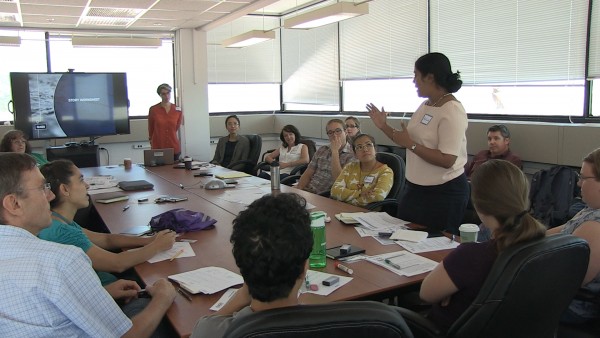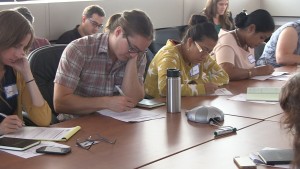21 July 2015
Sharing Science with the ten hundred most common English-language words
Posted by mcadams

Scientists practice their plain-language communications skills at a Sharing Science in Your Community workshop at UCAR on June 25. Photo by Derek Sollosi/AGU.
By Mary Catherine Adams
What if you were limited to using only the 1,000 most common words in the English language to explain your science? That’s what groups of scientists did this summer at several AGU Sharing Science communications skills-building workshops.
This year, for the first time, AGU’s Sharing Science program is offering on-site workshops at universities and scientific institutions. During each of these workshops, we ask participants to break into small groups and use the 1,000 most common words in the English language to describe a scientific concept of their choosing.
The exercise was inspired by an xkcd comic in which the artist, Randall Munroe, drew a diagram of the Saturn V rocket – the rocket that took astronauts to the moon – using only the “ten hundred” most common words in the English language. Munroe called it the “Up Goer Five” as neither the word “Saturn” nor “rocket” are among the 1,000 most common words. Scientists responded by creating their own “ten hundred” word descriptions of their science, many of which are collected on a Tumblr page called Ten Hundred Words of Science.
In the Sharing Science workshops, groups used a website called The Up-Goer Five Text Editor to create one-paragraph, plain-language blurbs. Similar to Microsoft Word, the Text Editor underlines words that are not among the 1,000 most common words.
The groups had about 15 minutes on average to create their blurbs. Although they were sometimes forced to use language so simple that it became comical, the participants pushed themselves creatively and the results were fantastic.
Here are some of the blurbs created by scientists attending Sharing Science workshops at the University Corporation for Atmospheric Research (UCAR), in Boulder, Colo., and Texas A&M’s Galveston, Texas, campus:
Ocean Acidification (for a K-6th grade audience)
By: Jillian Gilmartin, Kendra Kopp, John Rogers, and Ashley Whitt, Texas A&M
The big blue water body covering most of our world is taking in stuff from the air that changes the water so that it is hard for animals to make their houses. The animals don’t like being eaten and so they are in trouble without their houses, because they might die. If the animals die then we won’t have food. What is making the water change? When stores, houses, and cars run and stay warm they make bad air. This bad air is what gets into the water and makes it hard for the animals to make their houses. To save animal houses, we will need to make cars run better so that they make clean air! Land animals and water animals love clean air because it makes them happy!
Climate Change
By: Erin Mattson, Andrew McGuffin, Allison Myers-Pigg and Kevin Warner, Texas A&M
The world’s air changes over time. Air types over time are known. People put smoke into the air that changes the air very fast. The relationship of air and the smoke is also known. The fast air changes can be very bad. Animals and trees do not like the fast changes. The changes make it hard for the animals and trees to live. If the trees and animals die too fast, people might not be able to live well. People need to fix the smoke or humans will get on the struggle bus. Cities could die. Water will be hard to get. Food will not grow well. Instead, people need to walk or take the train to keep from making too much smoke. We need to grow some more trees. Using rocks to make lights work and get power is bad. We should use the sun instead.

Scientists work on a communications activity during a Sharing Science workshop at UCAR. Photo by Derek Sollosi/AGU.
Ocean Acidification
By: Piers Chapman, Ephraim Paul, Hannah Preischel, and Annie Tamalavage, Texas A&M
One of the big problems facing the world is that the water is starting to break down the outer covering of some animals that live there. This is because we are changing the air and stuff in the air goes into the water. The animals can’t make their covering any more and so die faster. If we don’t do something to stop this, we will change the world so much that we will lose money, food and even our own lives.
Emily Voytek’s hydrology research
By: Bridget Livers, Ashanthi Maxworth, Zitely Tzompa, and Emily Voytek, UCAR
I study how humans have changed how moving water looks and acts in the world around us. Often we take away trees and other green things from moving water to use them, and make the water look better, and make it easier to move through the water. However, we now know that taking these things out changes how the water moves and how animals and other living things can live in and around the water. When the trees are gone, there are fewer places for animals to live or find food.
Volcanoes
By: Katy Barnhart, Kristen Krumhardt and Kathy Smith, UCAR
Sometimes hot water rock comes out from inside the world. It makes a building of many rocks on top of one another. This forms tall land and can make new land in the big-water. Sometimes the land is hard to walk up. The hot water rock is made of slightly different stuff in different places. When the hot water rock comes out it makes noise and smoke. The hot water rock is bad for people and their homes. It is hard to know when the hot-water-rock will return.
It takes lots of preparation and practice to make complex science understandable to general audiences – certainly more than 15 minutes and highly restrictive vocabulary! That said, this exercise takes simplifying science to the extreme in a fun and simple way and hopefully makes anyone who tries it think twice about which words to choose when communicating to the general public.
For more Up-Goer Five blurbs from a 2013 AGU workshop, read Tiny vocabulary spurs scientists’ verbal creativity.
–Mary Catherine Adams is a public information specialist at AGU and is co-coordinator of AGU’s Sharing Science program. To learn more about AGU’s Sharing Science workshops, visit the Sharing Science Events page.
Have you created your own Up-Goer Five blurb? If so, consider submitting an abstract to the Make It More Simple: The Up-Goer Five Giving-It-a-Try (aka Challenge) session at the 2015 AGU Fall Meeting.


 The Plainspoken Scientist is the science communication blog of AGU’s Sharing Science program. With this blog, we wish to showcase creative and effective science communication via multiple mediums and modes.
The Plainspoken Scientist is the science communication blog of AGU’s Sharing Science program. With this blog, we wish to showcase creative and effective science communication via multiple mediums and modes.